How HashMap Works Internally? — Java
Easy guide to learn how HashMap works in java, let’s have a deep dive into HashMap and its internal working.

First of all, you must be familiar with the Collection tree before moving ahead for HashMap. You can find the Map interface and then the HashMap Class hierarchy.
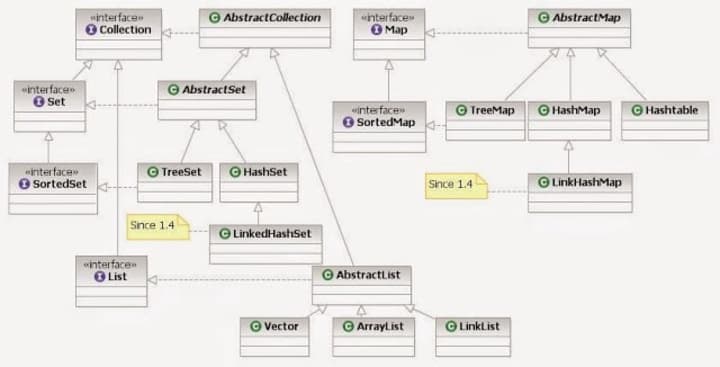
Don’t miss the Keynotes on “the internal working of HashMap” given at the end of this article.
What is HashMap in Java?
HashMap is a part of the Java collection framework. It uses a technique called Hashing. It implements the map interface. It stores the data in the pair of Key and Value. HashMap contains an array of nodes, and the node is represented as a class. It uses an array and LinkedList data structure internally for storing Key and Value. There are four fields in HashMap.
There are two main methods used for hashmap, so you must be aware of both of them.
The equals() and hashcode() are the two important methods provided by the Object class for comparing objects! Since the Object class is the parent class for all Java objects, hence all objects inherit the default implementation of these two methods.
- equals(): It checks the equality of two objects. It compares the Key, whether they are equal or not. It is a method of the Object class. It can be overridden. If you override the equals() method, then it is mandatory to override the hashCode() method.
- hashCode(): This is the method of the object class. It returns the memory reference of the object in integer form. The value received from the method is used as the bucket number. The bucket number is the address of the element inside the map. The Hash code of the null Key is 0.
Internal Working of HashMap in java
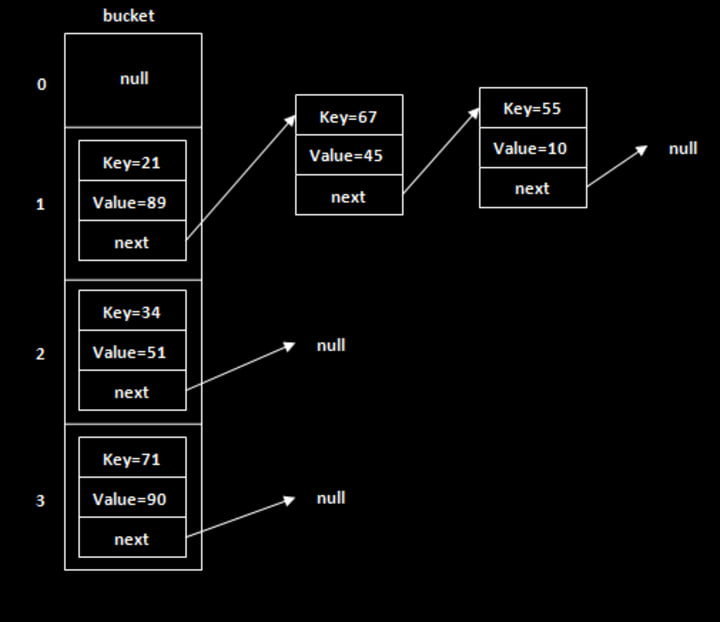
Buckets: The array of the node is called buckets. Each node has a data structure like a LinkedList. More than one node can share the same bucket. It may be different in capacity.
We use put() method to insert the Key and Value pair in the HashMap. The default size of HashMap is 16 (0 to 15).
HashMap map = new HashMap<>();
map.put("Rax",19);
map.put("Rakshit",29);
map.put("Robert",39);
From the above code snippet, let’s see at which index the Key, value pair will be saved into HashMap. When we call the put() method, then it calculates the hash code of the Key “Rax”. Suppose the hash code of “Rax” is 2657860. To store the Key in memory, we have to calculate the index.
Index minimizes the size of the array. The Formula for calculating the index is:
Index = hashcode(Key) & (n-1)
Where n is the size of the array. Hence the index value for “Rax” is:
Index = 8745511 & (16–1) = 4
The value 4 is the computed index value where the Key and value will store in HashMap.
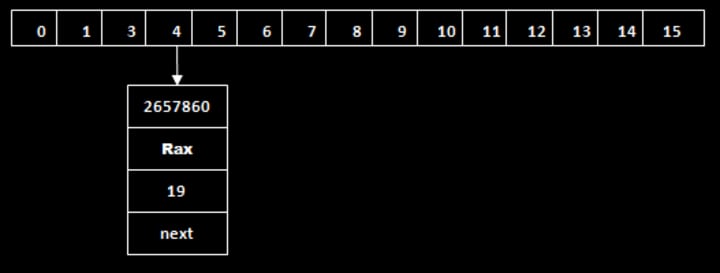
Now there might be chances that another key’s hashcode is equivalent to the code for key “Rax”. It is called “Hash Collision”.
The value 4 is the computed index value where the Key will be stored in HashMap. In this case, equals() method checks that both Keys are equal or not. If Keys are the same, replace the value with the current value. Otherwise, connect this node object to the existing node object through the LinkedList. Hence both Keys will be stored at index 4.
The value 4 is the computed index value where the Key will be stored in HashMap. In this case, equals() method checks that both Keys are equal or not. If Keys are the same, replace the value with the current value. Otherwise, connect this node object to the existing node object through the LinkedList. Hence both Keys will be stored at index 4.
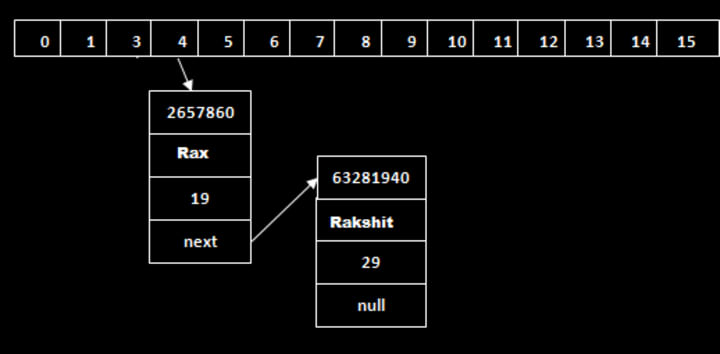
Similarly, we will store the Key “Robert.” Suppose the hashcode for the Key is 2349873. The index value will be 1. Hence this Key will be stored at index 1.
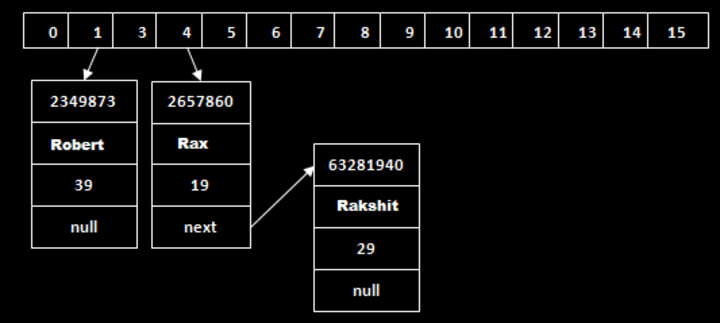
Now it is time for get() method.
get() method is used to get the value by its Key. It will not fetch the value if you don’t know the Key. When get(K Key) method is called, it calculates the hash code of the Key.
Suppose we have to fetch the Key “Rax”. The following method will be called.
map.get(new Key(“Aman”));
It generates the hash code as 2657860. Now calculate the index value of 2657860 by using the index formula. The index value will be 4, as we have calculated above. get() method search for the index value 4. It compares the first element Key with the given Key. If both keys are equal, then it returns the value else check for the next element in the node if it exists. In our scenario, it is found as the first element of the node and returns the value 19.
Let’s fetch another Key “Rakshit.”
The hash code of the Key “Rakshit” is 63281940. The calculated index value of 63281940 is 4, as we have calculated for the put() method. Go to index 4 of the array and compare the first element’s Key with the given Key. It also compares Keys. In our scenario, the given Key is the second element, and the next of the node is null. It compares the second element Key with the specified Key and returns the value 29. It returns null if the next of the node is null.
You must be aware of the entry class as well.
A map by definition is: “An object that maps keys to values…”.
So, there must be some mechanism in HashMap to store this key-value pair. The answer is YES. HashMap has a nested static class Entry, which looks like this:static class Entry implements Map.Entry
{
final K key;
V value;
Entry next;
final int hash;
...
}
Surely Entry class has key and value mapping stored as attributes. key has been marked as final and two more fields are there: next and hash.
If you want to see how can you fix the Collision in such a case, you can visit here for a detailed explanation with an example.
Keynotes on the internal working of HashMap
Data structure to store entry objects is an array named table of type Entry.
A particular index location in the array is referred to as bucket because it can hold the first element of a linked list of entry objects.
Key object’s hashCode() is required to calculate the index location of the Entry object.
Key object’s equals() method is used to maintain the uniqueness of keys in the map.
Value object’s hashCode() and equals() method are not used in HashMap’s get() and put() methods.
Hash code for null keys is always zero, and such entry object is always stored in zero indexes in Entry[].
I hope you find this article helpful. Feel free to drop any comments.
Reference:
[1] Java book - The Complete Reference by Herbert Schildt

Get my stories in your feeds by subscribing to me, or become a vocal+ member to read all stories of thousands of other writers, participate in all challenges and get a payout with low fees and less payout threshold on Vocal Media.
© Originally Published on HashMap Internal Working — Java, also republished on Medium by Author Rakshit Shah
About the Creator
Rakshit Shah
I am Computer Engineer and love to make websites and software. I am really eager to know about anything. I am curious to read and write cool stuff.






Comments
There are no comments for this story
Be the first to respond and start the conversation.